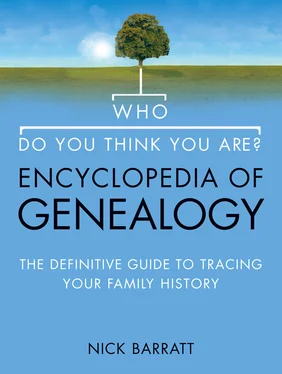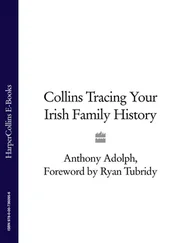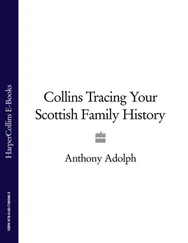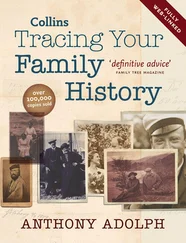Ask yourself why the document was created, and what information it was originally intended to provide. This will allow you to read it in its own context, and thereby understand why it is arranged the way it is. It may therefore be necessary to corroborate the source with one or more others before you can extract useful information from it. Most archives provide information leaflets about documents and why they were created, so set aside some time to read these useful articles so that you fully understand why you need to look at the documents. That way, you will come away with new names to add to your family tree, and a greater understanding of what they did to end up in an historical document.
‘Ask yourself why the document was created, and what information it was originally intended to provide.’
A good example is the search for a relevant death duty register (described in Chapter 8). Initially, they were created to provide information about the estate of a deceased person so that tax could be levied; but family historians now use them to track down the place where the will was registered, or to obtain further information about some of the beneficiaries in the will. At first glance, the notation used in the death duty register can be confusing or hard to read. Closer inspection, coupled with information contained in the accompanying research guide provided by The National Archives (where the records are stored) makes it easier to decipher the content of the document and allows you to extract the necessary data from the various sections of the register. This can then be used to find the will, and work out where some of the beneficiaries named in the will were living.
When you start working in an archive for the first time, you’ll need to be properly prepared. As well as following the above steps to locate an archive, locate documents within the archive, and ensure you interpret them correctly, you will also need to devote some time to the way you record and write up your findings. Here are some tips to help you.
Good note taking is an essential part of your research. If you spend a whole day in an archive, you could be wasting your time if you do not bother to record the exact searches you did, which indexes you looked at, the references of the documents you examined, what information these documents contained, and the names of any books you took copies from. You will find that the next time you go to the archives you will more than likely end up redoing searches you have already conducted simply because you cannot be sure whether you have done them or not.
‘ Good note taking is an essential part of your research. Record the exact searches you did, which indexes you looked at, the document catalogue references and the information those documents contained.’
You should establish a way of recording the parish register, civil registration and probate searches you have completed so that you know exactly which parishes, years and quarters you have looked at in case you need to extend these searches at a later date. Decide on a note-taking system that works for you. Most people use abbreviations for the terms that are repeated often throughout their work. You will probably find the abbreviations used in many family trees (see Chapter 2) are handy to learn. However, consistency in the way you write your notes is important so as not to confuse yourself. For example, if you start using ‘b.’ to indicate ‘born’, you should then decide on another abbreviation for ‘baptized’ and ‘buried’ – don’t use ‘b.’ for all three as you will soon get confused!
Some people prefer to take a laptop with them to the archives so they can type their notes straight into electronic form. But there will be occasions when a laptop will not be allowed in certain areas of an archive, so be prepared for this. You should always have a set of notes, whether written or electronic, which you can take into the archives with you to work from. Keep hold of your research plans and ensure you record how much of it you achieved so that you know how much you need to do on your next visit. Date your notes so that you can keep a chronological track of your progress and can work from the most recent set of notes, and record the name of the archive you visited to avoid confusion, just in case two archives use a similar referencing system for their documents.
When you are taking notes it is important to record the source of absolutely everything, whether it is a person, an archive, a website or a book. When writing document references be sure to include the exact page and folio numbers where you found the correct entry so that you can find it again easily if you need to, even the line on which it was written. If you consult a document that turns out to be of no use, make a note of this so that you do not go back to it again.
Secondary sources also contain valuable information for family historians, so when you take a photocopy from a book or write out a paragraph from it, record its full title, the author’s name, the publisher and year of publication, which should be found on the inside cover, as well as the relevant page numbers. Recording the year of publication for books will be surprisingly useful to your research. You may find a fascinating paragraph in a local history book describing the house your ancestors used to live in, but if you don’t bother to look at when the book was published you won’t be able to put that description into its own historical context. Many history books were published in the nineteenth and early twentieth centuries, a lot of which are still in our libraries today, and their descriptions of events and places will differ from those of more recent authors.
‘It is important to distinguish between evidence and analysis in your notes, otherwise mistakes will start to creep into your work.’
It is important that your notes distinguish between what is evidence and what is analysis. When you return to your notes at a later time, perhaps to type them up or to remind yourself what you found on your last visit to the archives, you need to be able to rely on them. Therefore, if you transcribe a passage from an original document, put that paragraph in speech marks so you know that was what was written word-for-word. If there are any phrases you are unsure of put them in square brackets, because assuming the meaning of a few words could alter the entire context of a piece of text. Anything you have scribbled down as presumption, analysis or ideas should be labelled clearly as being so, because these opinions may change as you find more documents. You want to avoid confusing fact with ideas, otherwise mistakes will start to creep into your work.
A genealogy project produces an enormous amount of paperwork, from your research notes and photocopied documents to the photographs you find and the family papers your relatives give you. Sooner rather than later you will undoubtedly find that you don’t know what to do with it all! It is very tempting to just pile it all into a big box and hide it under the bed, but that would be a huge shame after all your hard work, not to mention that it makes finding documents and notes you need to work from a bit of a nightmare.
There are various filing systems you can adapt to suit your own purposes. It is worth investing in a decent expandable file with plenty of dividers and labels. And you may prefer to showcase some key documents in a portfolio file to keep them pristine. There are many ways of organizing your paperwork. You might want to classify your notes alphabetically by surname, or perhaps keep all the notes from one archive visit together, but it does help to keep copies of original documents together with the relevant notes. It can be useful to separate your notes for each side of the family, and then by surname and branch, especially if the same surname appears in two different branches.
Читать дальше












